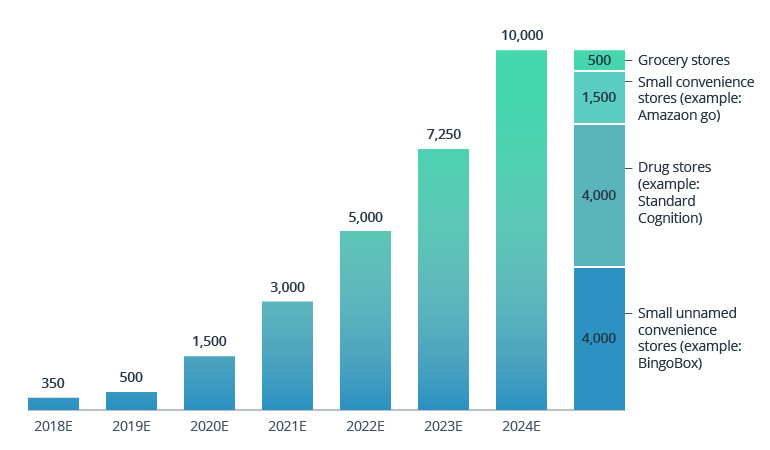Retail has come a long way — from the first brick-and-mortar stores to global retail chains that leverage smart technologies to add value to their operations. In fact, AI is projected to account for $27.24 billion in the retail market by 2025.
Despite all these advances, the checkout experience is still the Achilles’ heel of retail stores. Half the customers are ready to abandon their shopping carts due to long checkout queues.
To cope with this challenge, big-box retailers are investing in automated checkout systems, an innovative retail solution that would take the in-store experience to the next level. It was Amazon that pioneered the technology in its Amazon Go store. Now, more and more companies are testing the water, and the number of stores with autonomous checkouts is set to rise to 10,000 by 2024.
Global Store with Autonomous Checkouts

Source: Business Insider Intelligence estimates
Before we get into the nitty-gritty of autonomous checkouts, let’s take a step back and have a look at how we got here.
From self-checkouts to autonomous checkouts
The final touchpoint in your customer’s journey, the checkout process can make or break the sale. To streamline the whole shopping experience, retailers introduced self-checkouts that allowed customers to process their own purchases. Kmart was the first big-box American retailer to open stores with self-checkout back in 2001.
Self-checkout systems put customers in full control over their buying process from the store shelf to the home pantry. For a seamless shopping experience, numerous self-checkout payment options are available, including credit cards and mobile payments. And since self-checkouts are replacing cashiers, the technology can significantly improve staff efficiency and free up employees for other value-added activities.
With self-checkout trends on the rise, let’s have a look at some of the ways that the technology is implemented.
Scan-and-go
Retailers are experimenting with the scan-and-go technology that lets customers use a portable scanner or mobile phone to scan items as they put them in a shopping cart. When shoppers are ready to check out, they can pay at a POS terminal or using their mobile, via online payment systems like Apple Pay, Google Pay, and others.
Click-and-collect
Also known as “buy online, pick up in store”, click-and-collect combines the convenience of eCommerce and retail software solutions with the speed of in-store pickup. In addition to the immediacy that traditional delivery can hardly match, click-and-collect also reduces transportation costs. In fact, click-and-collect is set to grow by 45% by 2023.
Mobile checkouts
Another alternative is mobile checkout stations, which allow employees to check customers out anywhere in the store. Equipped with a special portable device for item scanning and payment processing, sales associates can help customers on the spot, which is of particular importance during busy weekends and holiday seasons.
While there’s no doubt that all these techniques significantly improve the shopping process, it’s the autonomous checkouts that revolutionize the in-store checkout experience for customers.
Benefits of autonomous checkouts
Setting a new standard for convenience, an automated checkout system allows customers to walk in, grab what they want and then leave the store without having to physically check out. The technology that was considered the province of science fiction just a decade ago has become reality.
From the customer’s perspective, the benefits of cashierless stores are numerous:
- No long waiting times in checkout lines
- 24/7 opening hours
- Frictionless sales process
- Seamless overall shopping experience
Besides eliminating the customers’ biggest pain point, the value in automated self-checkout systems for retailers is in increased operational efficiency and higher profit margins. Companies that invest in self-checkout system development are able to free up human resources for more value-added activities like helping and engaging customers on the floor.
Also, using smart technologies to automate the checkout process allows for more sophisticated capture of valuable data and, hence, for better understanding of customers. These data-driven insights can be used to further inform a retail strategy and deliver better, personalized shopping experiences at scale.
Under the hood
So, how does a cashierless store work? The technology behind autonomous checkouts is similar to that underpinning self-driving cars — a combination of sensors, cameras, computer vision and deep learning.
When customers enter a store, they use a dedicated mobile app to check in. Then, CV-enabled cameras and smart sensors track shoppers as they move through the store, pick up items and put them into a shopping cart or back on the shelf. As customers leave the store, the system automatically bills them, via the app, for the merchandise they’ve taken.
The bottom line
Once thought of as a remote dystopian perk, cashierless store technology is now taking off as a promising alternative to self-checkout stores. In no small part, its success is underpinned by advancements in computer vision, machine learning, and cheaper sensors.
Retailers are harnessing the power of autonomous checkouts to meet the customers’ demand for a frictionless checkout experience and bring an end to waiting in lines. And although retrofitting a store may seem like high up-front costs, in the long run the technology has the potential to improve retail efficiency and boost profit margins.
Get in touch with our experts to learn how to bring your retail store into the modern age with state-of-the-art machine learning and computer vision technologies.

